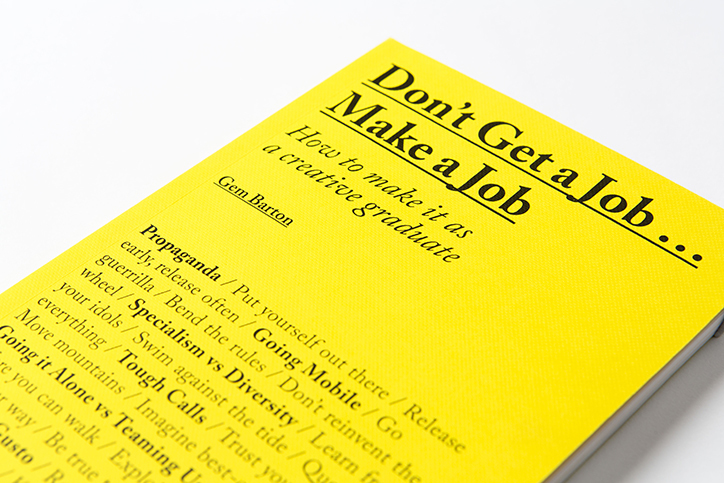Off the back of my work The Open Mouth That Offers Up Nothing, the lovely folks at Photofusion offered me a place on a segment of a Professional Development Unit specifically focused on Socially Engaged Practice. Not considering my work was this in exactly these terms before, this was a useful stepping stone to understanding my own practice in different terms, for the better.
Inspiration comes from Reflection
Prior to this course, it is definitely worth mentioning some of the thoughts that I was having when I took a small hiatus to the New Forest for some moments to reflect in solitude at moments surrounded by nature, wildlife, the occasional deer and many bumpy rides over cattle grids. One reflective Wednesday afternoon, whilst reading an amazingly written, designed and put together text Don’t Get A Job… Make a Job by Gem Barton, the text opened my mind up to the potential for me to lead the way in creating my own practice, which works for me, facilitated by workshops and teaching.
Don't Get a Job... Make a Job by Gem Barton
Photograph: https://www.itsnicethat.com/articles/creative-graduates-gem-barton-180216
Me mentioning this will become relevant later on in relation to workshops, public programmes and working alongside participants to convey what you wish to. I’ll also follow up with an article about this book, for sure.
The First Morning
Back to the morning following my graduation, feeling apprehensive, not ready to meet some new people, not really feeling ready to confront my practice so head on (you know those moments where you’re not really in it), I was soon greeted with the term socially engaged and what this meant in relation to my recent work on stammering. It was a delightful experience. Being tasked with writing my own definition, I knew what was to come was going to change my perception of this thing socially engaged practice. Unfortunately, I lost my first first post it note I wrote with my definition on it on day one (that would have made for a nice before and after photo below this paragraph). I remember it being very vague and wishy-washy. Mainly thinking about the audience which will receive the work, not any of things I discovered later on into the course.
“I was soon greeted with the term socially engaged and what this meant in relation to my recent work on stammering.”
The course’s framework set it up as if we were mainly thinking about socially engaged practice in the context of a workshop which would be delivered, or an artist’s practice where they would work with participants. One amazing example of this is D. Wiafe’s work, an Artist in Residence at Photofusion who is concerned with British Youth, delving much deeper into nuances, these nuances coming directly from adolescent participants themselves.
Five Takeaways
So, it’s not particularly useful for me to list all of the contents of the course, plus my workshop leader would then be out of a job! But I’ll mention five aspects of the course with influenced my flowing or not-flowing practice the most:
Importance of audience and different types of audience – Audience is crucial to your piece of work. However, even more crucial to socially engaged practice is that the audience is participatory, within the outcome of the work as well its process. Participation can be both active or passive. Whether active or passive, the collaborators on the project have just as much as an equal buy in to the work as the artist.
Outcomes – the outcome of the project you’re creating sits in the mind of the artist, you can have all the intentions you want, but what the people on the project you’re working on with them have cannot ever be decided by the practitioner leading the course.
Definition – socially engaged concerns the relationship of artist and participant. The artist does not necessarily dictate the outcome.
Roles – everyone on a project has a role on the project, whether it be the artist or the teacher. How do their roles differ? They differ greately, they each hold varying levels of power, and may require different skills and knowledge compared to others. This is important when crafting a workshop.
Workshop planning – being tasked with creating my own workshop plan was a challenge. The main challenge for me was making sure that a workshop I would like to revolve completely around stammering and creativity would be relevant to a wider audience. Whether this means broadening out the scope for exploration, i.e looking into broader topics around flow, disruption, the glitch. These tangible topics would interest the innocent participant looking to broaden their knowledge and understanding, when looking to sign up to an artistic workshop or course.
“Being tasked with creating my own workshop plan was a challenge.”
The most important thing though, is summing up how this course has supported my own current practice, how It can move forward and how it can support my plans to develop workshops.
My Practice is Socially Engaged
There is an issue, I’m attempting to raise awareness, provide a platform for others who stammer and expand my artistic skills at the same time as doing I love and feel makes a direct impact on lives, instead of some conceptual bullshit.
“I’m attempting to raise awareness, provide a platform for others who stammer and expand my artistic skills”
How do I know that my work is socially engaged? Me, being the artist, has all of the intentions in the world, but my work is defined by the participants who collaborate with me to make the project. The project idea usually stems from my head, but is always influenced and manipulated by others. This is socially engaged. Furthermore, the issue I’m concerned with directly impacts quality of life, whether this be disruption, flow then speech difficulties, then more specifically stammering.



